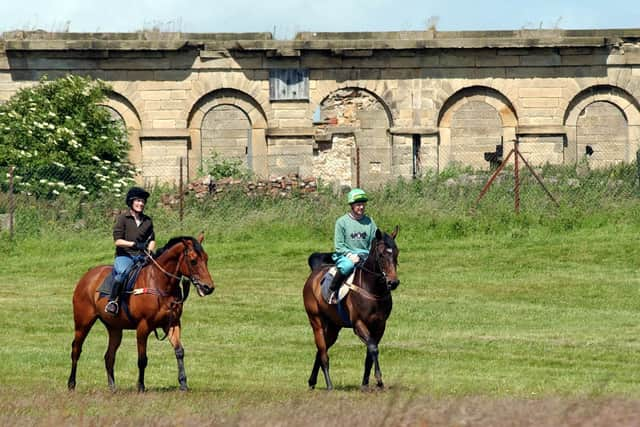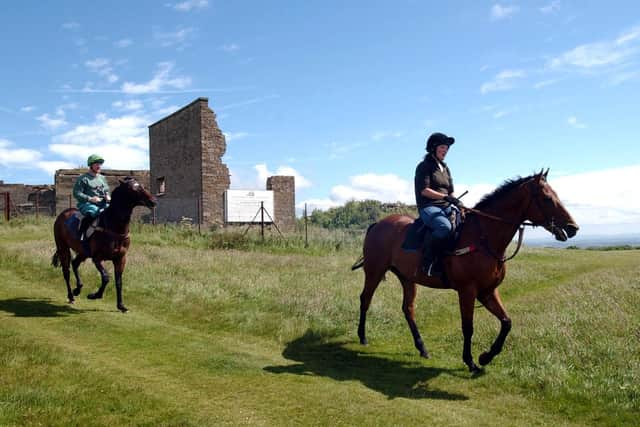Row breaks out in Richmond after aristocrat applies to de-register historic Georgian grandstand on site of town's old racecourse
A North Yorkshire County Council planning meeting heard how hereditary peer the Earl of Ronaldshay was seeking to de-register three listed buildings on the former Richmond Racecourse site at Low Moor from the national registry of common land. The racecourse has been disused since 1891.
The Earl, Robin Dundas, is the eldest son of the Marquess of Zetland of nearby Aske Hall. The family are major landowners in the area and their ancestors had a private stand at the course.
Advertisement
Hide AdAdvertisement
Hide AdA report by eminent historian Professor Mike Huggins, which was commissioned by the Earl, highlighted that while the Georgian grandstand was of "major architectural importance" it was of even more significance historically and culturally in the history of horseracing.


After the King’s Plate was run at Hambleton, above Sutton Bank, for the last time in 1775, George III decided it should be staged at York and Richmond alternately, with a new grandstand being completed in 1777 for its first hosting of the high status race.
Prof Huggins' report states: "It provided a place for the local landed elite and those socially ambitious local middling groups, corporation families, merchants and attorneys, who could afford entry, allowing some limited social mixing and enabling them to see and be seen.
"Folk there were separated from the rest of the crowd, literally and metaphorically looking down on everyone else, while visibly demonstrating their presence and superiority."
Advertisement
Hide AdAdvertisement
Hide AdIn a statement on behalf of Richmondshire Racecourse Restoration and Revival Committee, the Earl said that in a rush to register common land in 1968, the local council had made an error over the buildings on Low Moor.


He said once the "miscarriage of justice" had been rectified their capacity to address the "serious decay" of the grandstand, which was on English Heritage's At Risk register, the judges’ box and stewards’ stand, would improve.
In the statement he said the grandstand was by celebrated architect John Carr, but "due to negligence has fallen into a terrible state of disrepair".
He said: "Whilst the buildings are still classed as part of a common, practical solutions for renovations are all but impossible to conceive, given the regulatory protections afforded to commons."
Advertisement
Hide AdAdvertisement
Hide AdHowever, the meeting heard that local life peer Baroness Angela Harris of Richmond had stated the move to also deregister common land surrounding the buildings appeared unjustified. She said the application had not indicated how removing it as common land would improve the management of the common or better protect it.
She added: "Nor does it indicate how it would better secure the conservation of the heritage structures themselves which could presumably be stabilised, whether or not they are identified as being within common land."
The baroness said the removal of areas surrounding the buildings "would diminish the extent of the common land and could lead to fencing and subsequent obstruction of areas of land which currently enjoy a right of public access".
Also objecting, her husband, the longest serving Richmond town councillor, John Harris, said "it made complete sense" for the common land to include the grandstand.
Advertisement
Hide AdAdvertisement
Hide AdPlanning papers stated talks had been held between the Earl and the objectors "on an entirely amicable basis", but the dispute over the area surrounding the buildings was not resolved.
The meeting was told as the buildings had been disused for decades, examining their historic use was vital in determining the extent of the curtilage surrounding them.
Prof Roberts had concluded the 18th century curtilage "probably took a line similar to that of the modern circular pathway around the stand, so "spectators could promenade, socialise and talk to others outside the enclosed space between races".
Ahead of the deregistering application being approved, the committee's chair, Councillor Peter Sowray said: "It is reasonable to expect that there should be a curtilage around buildings and 15 yards, or five yards around the Judges Box is not a massive distance."
Comment Guidelines
National World encourages reader discussion on our stories. User feedback, insights and back-and-forth exchanges add a rich layer of context to reporting. Please review our Community Guidelines before commenting.